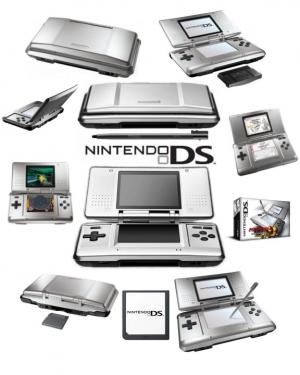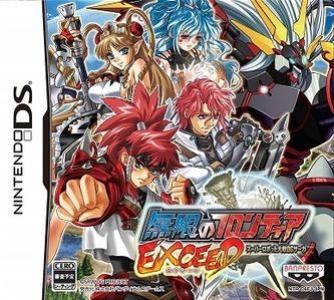
Nintendo DS
Nintendo DS Specifications
| Manufacturer: | Foxconn |
| Developer: | Nintendo |
| CPU: | ARM946E-S, ARM7TDMI |
| Memory: | 4 MB RAM |
| Graphics: | ARM946E-S |
| Sound: | ARM7TDMI, stereo with 16 PCM/ADPCM channels, facilitated by the Mitsumi MM3205B |
| Medium: | Cartridge |
| Display: | Two TFT LCDs, 256 × 192 pixels |
| Controllers: | 1 |
The Nintendo DS (abbreviated to DS or NDS) is a portable game console produced by Nintendo, first released on November 21, 2004. A distinctive feature of the system is the presence of two separate LCD screens, the lower of which is a touchscreen, encompassed within a clamshell design, similar to the Game Boy Advance SP. The Nintendo DS also features a built-in microphone and supports wireless standards, allowing players to interact with each other within short range, or online with the Nintendo Wi-Fi Connection service. The Nintendo DS is the first Nintendo console to be released in North America before Japan.
The DS, an initialism for "Developers' System" or "Dual Screen", introduced distinctive new features to handheld games: two LCD screens working in tandem (the bottom one being a touchscreen), a built-in microphone and support for wireless connectivity. Both screens are encompassed within a clamshell design similar to the Game Boy Advance SP. The Nintendo DS also features the ability for multiple DS consoles to directly interact with each other over Wi-Fi within a short range without the need to connect to an existing wireless network. Alternatively, they could interact online using the now-defunct Nintendo Wi-Fi Connection service. Its main competitor was Sony's PlayStation Portable during the seventh generation of video game consoles.
One of the unique features of the DS is its ability to play games in both 2D and 3D, depending on the game and the player's preference. It was also one of the first gaming devices to introduce touch-based gameplay, which allowed for new types of gameplay experiences.
Prior to its release, the Nintendo DS was marketed as an experimental "third pillar" in Nintendo's console lineup, meant to complement the Game Boy Advance family and GameCube. However, backward compatibility with Game Boy Advance titles and strong sales ultimately established it as the successor to the Game Boy series. On March 2, 2006, Nintendo launched the Nintendo DS Lite, a slimmer and lighter redesign of the original Nintendo DS with brighter screens and a longer lasting battery. On November 1, 2008, Nintendo released the Nintendo DSi, another redesign with several hardware improvements and new features, although it lost backwards compatibility for Game Boy Advance titles and a few DS games that used the GBA slot. On November 21, 2009, Nintendo released the Nintendo DSi XL, a larger version of the DSi.
The DS had a large library of games, including popular titles such as Super Mario Bros., The Legend of Zelda, and Pokémon. It was a very successful console that all Nintendo DS models combined had sold 154.02 million units, making it the best-selling Nintendo system, the best-selling handheld game console, and the second-best-selling video game console of all time, overall, behind Sony's PlayStation 2. The Nintendo DS was succeeded by the Nintendo 3DS in February 2011.
Latest on Nintendo DS

Pokémon Volt White 2 Redux
The ability to catch all 649 Pokémon in a single playthrough. A revamped trainer roster and two optional difficulty modes. Challenge Mode will push...

Pokemon Conquest: Ultimate
Pokémon Conquest: Ultimate is a Gen 9 mod that adds 200 fully evolved Pokémon, including 150 new Gen 9 additions, to the original Pokémon Conquest gam...

Pokémon Mystery Dungeon: Explorers of the Spirit (WRONG - SHOULD BE GBA)
What is the spirit? Experience a new, full-length story about our familiar comforts and uncomfortable changes. Features newly redesigned dungeons, a...

Super Robot Taisen OG Saga: Endless Frontier EXCEED
Super Robot Wars OG Saga: Endless Frontier EXCEED is a sequel to the original Super Robot Wars OG Saga: Endless Frontier on DS only released in Japan....

Asphalt 4 Elite Racing
Asphalt 4 - Elite Racing, developed and published by Gameloft and released as DSi ware in 2009. Originally released on Mobiles in 2008. "The world is...

Flips: Too Ghoul for School
If your kids enjoy a good book, but you still have trouble getting them to read, then try turning on your DS instead. This unique interactive adventur...

Horrid Henry’s Horrid Adventure
Margaret has stolen all of Henry's stuff. It's up to you to travel through 3 lands to get it all back! The DS game features the song Alara - Pixelated...

I’m a celebrity get me out of here
Camp deep in the dark sweltering jungle with a group of celebrities and take on challenges that put your bravery, resilience and intelligence to the t...

008 Pokemon Nero 2
In Pokémon Versione Nera 2 i giocatori ritornano nella regione di Unima, due anni dopo gli eventi di Pokémon Versione Nera e Pokémon Versione Bianca. ...

009 Pokemon Bianco 2
In Pokémon Versione Nera 2 i giocatori ritornano nella regione di Unima, due anni dopo gli eventi di Pokémon Versione Nera e Pokémon Versione Bianca. ...